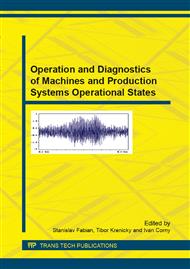[1]
Z. Zhao, S.Y. Hong, Cooling strategies for cryogenic machining from a materials viewpoint, J. Mater. Eng. Perform. 1 (1992) 669-678.
DOI: 10.1007/bf02649248
Google Scholar
[2]
O.W. Dillon, R.J. De Angelis, W.Y. Lu, J.S. Gunasekera, J.A. Deno, The effects of temperature on the machining of metals, J. Mater. Shaping Technol. 8 (1990) 23-29.
DOI: 10.1007/bf02834790
Google Scholar
[3]
M. Dhananchezian, M. Pradeep Kumar, A. Rajadurai, Experimental investigation of cryogenic cooling by liquid nitrogen in the orthogonal machining process, Int. J. Recent Trends Eng. 1 (2009) 55-59.
Google Scholar
[4]
N.R. Dhar, M. Kamruzzaman, Cutting temperature, tool wear, surface roughness and dimensional deviation in turning AISI-4037 steel under cryogenic condition. Int. J. Mach. Tools Manuf. 47 (2007) 754-759.
DOI: 10.1016/j.ijmachtools.2006.09.018
Google Scholar
[5]
S. Sun, M. Brandt, M.S. Dargusch, Thermally enhanced machining of hard-to-machine materials – A review, Int. J. Mach. Tools Manuf. 50 (2010) 663-680.
DOI: 10.1016/j.ijmachtools.2010.04.008
Google Scholar
[6]
S.S. Gill, J. Singh, R. Singh, H. Singh, Metallurgical principles of cryogenically treated tool steels – a review on the current state of science, Int. J. Adv. Manuf. Technol. 54 (2011) 59-82.
DOI: 10.1007/s00170-010-2935-5
Google Scholar
[7]
A. Molinari, M. Pellizzari, S. Gialanella, G. Straffelini, K.H. Stiasny, Effect of deep cryogenic treatment on the mechanical properties of tool steels, J. Mater. Process. Technol. 118 (2001) 350-355.
DOI: 10.1016/s0924-0136(01)00973-6
Google Scholar
[8]
H.S. Yang, J. Wang, B.L. Shen, H.H. Liu, S.J. Gao, S.J. Huang, Effect of cryogenic treatment on the matrix structure and abrasion resistance of white cast iron subjected to destabilization treatment, Wear 26 (2006) 1150-1154.
DOI: 10.1016/j.wear.2006.03.021
Google Scholar
[9]
S. Li, Y. Xie, X. Wu, Hardness and toughness investigations of deep cryogenic treated cold work die steel, Cryogenics 50 (2010) 89-92.
DOI: 10.1016/j.cryogenics.2009.12.005
Google Scholar
[10]
P.F. Stratton, Optimising nano-carbide precipitation in tool steels, Mater. Sci. Eng. A-Struct. Mater. Prop. Microstruct. Process. 449-451 (2007) 809-812.
DOI: 10.1016/j.msea.2006.01.162
Google Scholar
[11]
M. Satish Kumar, D. Mohan Lal, S. Renganarayanan, A. Kalanidhi, An experimental investigation on the mechanism of wear resistance improvement in cryotreated tool steels, Indian J. Eng. Mat. Sci. 8 (2001) 198-204.
DOI: 10.1016/s0011-2275(01)00065-0
Google Scholar
[12]
V. Firouzdor, E. Nejati, F. Khomamizadeh, Effect of deep cryogenic treatment on wear resistance and tool life of M2 HSS drill, J. Mater. Process. Technol. 206 (2008) 467-472.
DOI: 10.1016/j.jmatprotec.2007.12.072
Google Scholar
[13]
M. Preciado, P.M. Bravo, J.M. Alegre, Effect of low temperature tempering prior cryogenic treatment on carbonised steels, J. Mater. Process. Technol. 176 (2006) 41-44.
DOI: 10.1016/j.jmatprotec.2006.01.011
Google Scholar
[14]
D. Das, A.K. Dutta, K.K. Ray, Correlation of microstructure with wear behaviour of deep cryogenically treated AISI D2 steel, Wear 267 (2009) 1371-1380.
DOI: 10.1016/j.wear.2008.12.051
Google Scholar
[15]
A.J. Vimal, A. Bensley, D.M. Lal, K. Srinivasan, Deep cryogenic treatment improves wear resistance of En 31 steel, Mater. Manuf. Process. 23 (2008) 369-376.
DOI: 10.1080/10426910801938098
Google Scholar
[16]
M. Hashish, A model for abrasive - waterjet (AWJ) machining, J. Eng. Mater. – T. ASME 111 (1989), 154-162.
DOI: 10.1115/1.3226448
Google Scholar
[17]
L.M. Hlaváč, JETCUT - software for prediction of high-energy waterjet efficiency, in: H. Louis (Ed.), 14th International Conference on Jetting Technology, BHR Group Limited, Prof. Eng. Pub. Ltd., Bury St Edmunds & London, Brugge, Belgium, 1998, pp.25-37.
Google Scholar
[18]
M. Kantha Babu, O.V. Krishnaiah Chetty, Studies on recharging of abrasive water jet machining, Int. J. Adv. Manuf. Technol. 19 (2002) 697-703.
DOI: 10.1007/s001700200115
Google Scholar
[19]
L.M. Hlaváč, Investigation of the Abrasive Water Jet Trajectory Curvature inside the Kerf, J. Mater. Process. Technol. 209 (2009), 4154-4161. (.
DOI: 10.1016/j.jmatprotec.2008.10.009
Google Scholar
[20]
L.M. Hlaváč, I.M. Hlaváčová, L. Gembalová, J. Kaličinský, S. Fabian, J. Měšťánek, J. Kmec, V. Mádr, Experimental Method for Investigation of the Abrasive Water Jet Cutting Quality, J. Mater. Process. Technol. 209 (2009), 6190-6195. (doi:10.1016/j.jmatprotec. 2009.04.011).
DOI: 10.1016/j.jmatprotec.2009.04.011
Google Scholar


